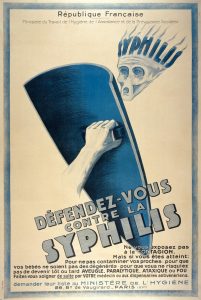This post is part of our Research Initiation Scheme for 2020-2021.
On Friday 16th October 2020, Dr Steven Wilson (French, QUB) gave a talk on his research on ‘The Contact Zones of Disease: Sites of Infection and Contagion in the Nineteenth-Century French Syphilis Narrative’. This seminar talk was the first of the Semester 1 Modern Languages Core Disciplinary Research Group series. The talk centred on how we use the language of infection, infestation and warfare to talk about the diseased body, the concept of borders in our understanding of disease, and the representations of syphilis in 19th century French literature.

Credit: A shield to protect against syphilis represented as a skull. Lithograph, 1924/1930. Credit: Wellcome Collection. Attribution 4.0 International (CC BY 4.0)
I found the introduction of the talk to be particularly interesting as, using an example from Donald Trump, Dr Wilson described how the American President uses the language of infestation to talk about immigrants, saying that they ‘infest’ the country. This language would normally be used to describe a poisonous insect or animal, but Trump uses it to express his fear of immigrants crossing the border and, more importantly, to mark them as a threat to public health. Derogatory language like this is unpleasant to hear, but it is not a new concept. For centuries, we have been using the language of infectious diseases to describe the borders and boundaries that mediate human contact. Even now, amidst the coronavirus pandemic, travellers crossing borders must quarantine to prevent the spread of the disease, and positive cases are forced to isolate. All of this causes us to regard the diseased body as the dangerous body, something that must be contained in order to protect the lives of others, and a border as something that keeps us safe. Moreover, Western societies are obsessed with the image of disease-carrying immigrants and feel threatened by the idea of the ‘contact zone’, or the spaces where cultures meet. The deadliest pandemic of the 20th century was called the Spanish influenza as the first cases were diagnosed in Spain, and even today, we have the ‘Chinese virus’, as labelled by Trump. These examples highlight how the language of borders is deeply ingrained in how diseases are represented and understood.